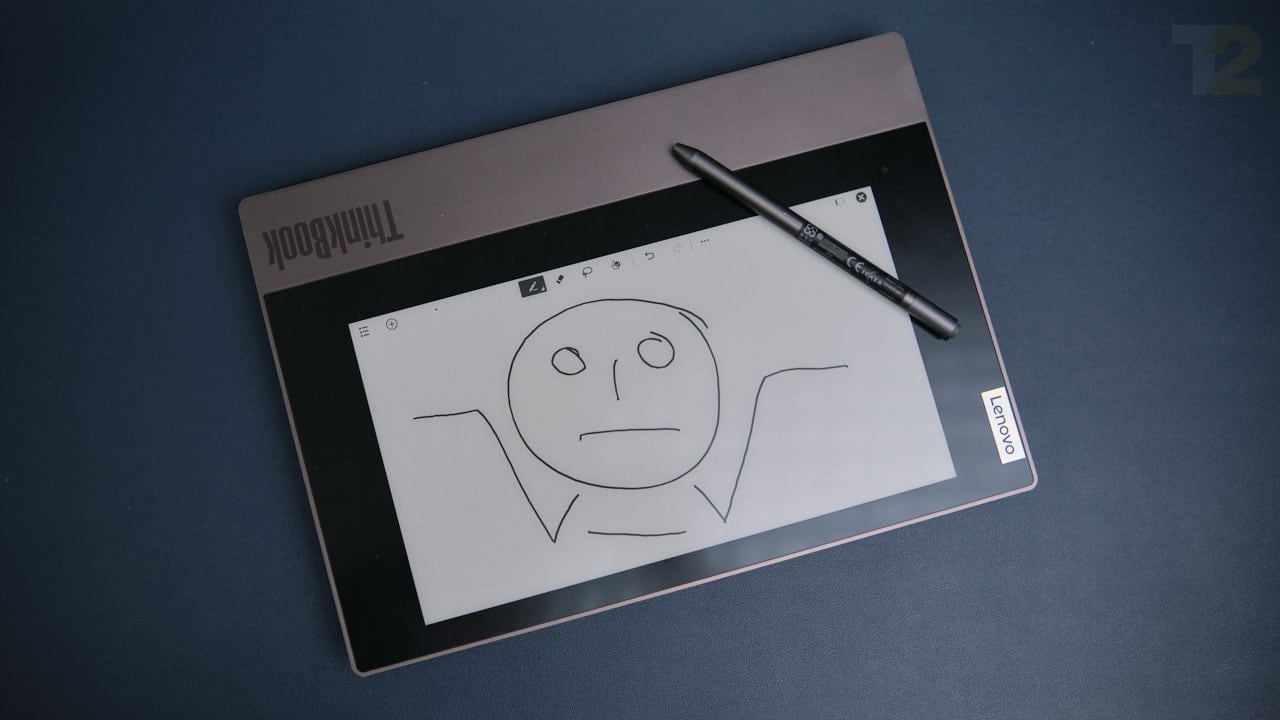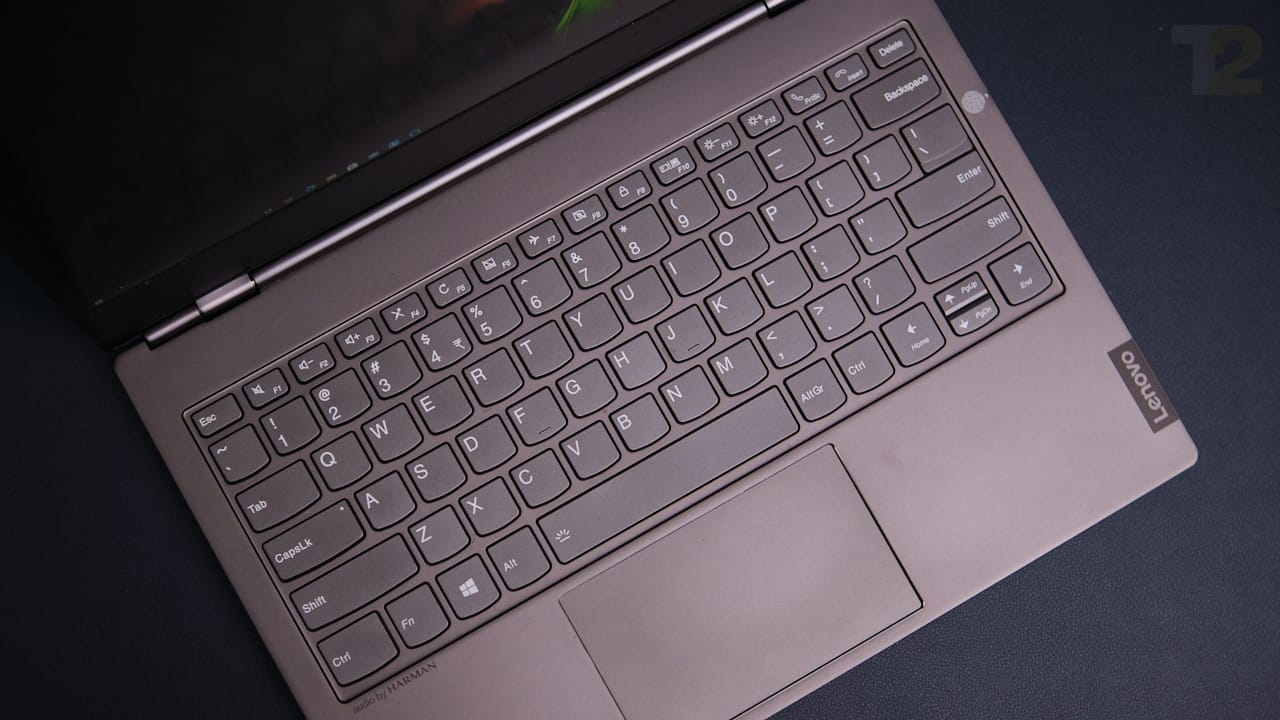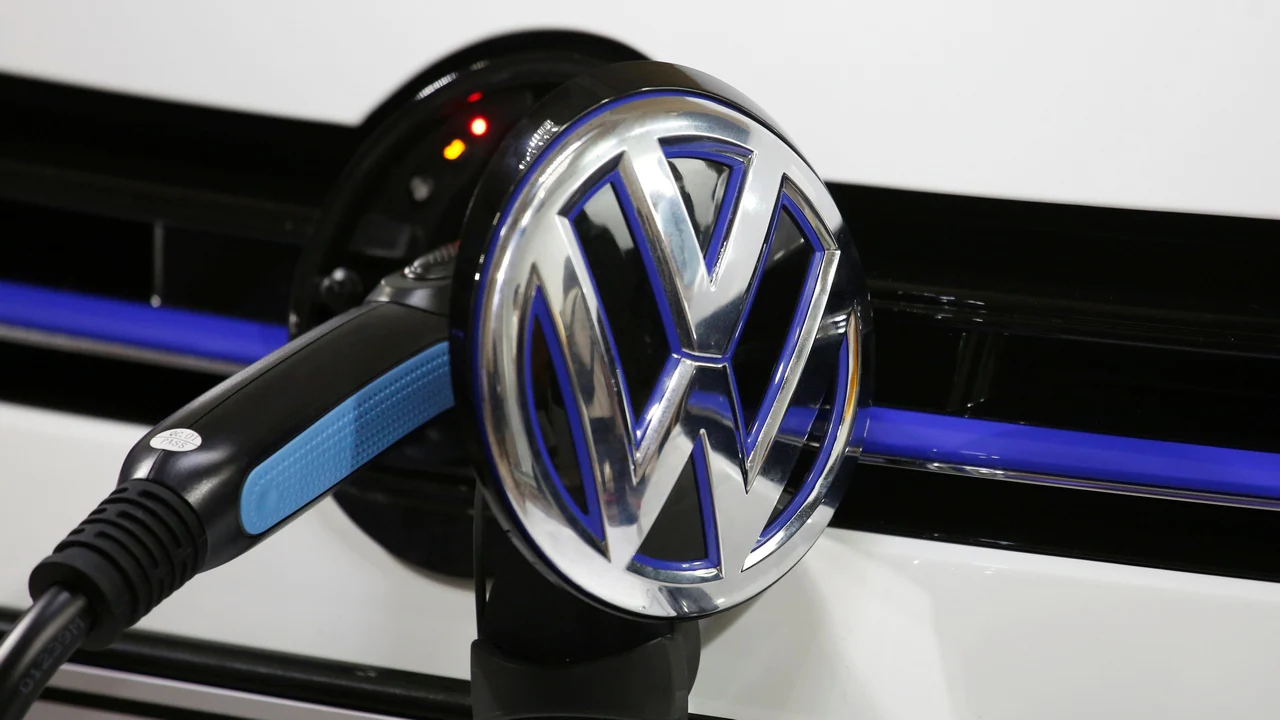Anirudh RegidiMay 04, 2021 15:37:57 IST
At Rs 1,40,000, this ThinkBook Plus is a premium laptop. Given that it’s powered by a 14nm 10th Gen Comet Lake CPU when the world has moved on to 11th Gen Intel parts and 7 nm 5th Gen AMD Ryzens, however, it’s not really packing premium hardware.
You get a decent display, a great keyboard, weak speakers and tolerable battery life. There’s a fingerprint reader on the side, and the lid is about as thick as the body. It’s too heavy to be an Ultrabook but not powerful enough to be anything more than a daily driver for office work.
So why does it cost so much?
Well, take a closer look at the lid and you’ll notice that it’s not just a lid, it’s a secondary display. And not just any display, this is an e-ink display – yes, the same tech you’ll find in a Kindle’s screen.
Given its price, you’re certainly not buying this laptop for display quality, aesthetics, or performance. You’re buying it for that e-ink display, and you’re willing to put up with the added weight, bulk, and slower CPU for the pleasure of using that display.
This begs the question: Is it worth it?
Before I answer that, let me just get the regular laptop stuff out of the way.
While it’s powered by a low-power Intel Core i7 CPU, Lenovo appears to have either dialed the CPU down to an even lower power setting, or decided that silent cooling is more important than adequate cooling. In either case, the laptop scores poorly in CPU benchmarks, and doesn’t even manage to hit its 1.1 GHz base clock under load.
When using Word or Excel, performance seems adequate and the silence is appreciated. However, browsing the web is a different matter. You can feel the system slow down when too many tabs are open, and in fact, browser benchmarks indicate that this is one of the slowest laptops we’ve tested since the start of the pandemic (mask-up, people, and stay safe). The only machine that’s slower is the Microsoft Surface Go 2, and that machine uses an even lower power Core M3 CPU.
Otherwise, the laptop is great. The display covers 91 percent of the sRGB spectrum and at 1520:1, boasts of the highest contrast ratio I’ve seen on an LCD display. Text is sharp and clear and pleasing to the eye. As expected from Lenovo, the keyboard is also great. The keys are easy to index, and while a little stiff, feel good to type on. The speakers are inadequate, though. I could barely hear them over my ceiling fan and I even struggled to follow conversations in a couple of meetings.
Battery life was passable, but not enough for a full day. At 120 nits – or about half-brightness – the laptop only managed to last a little under 6 hrs. Laptops in this price category – unless they’re gaming laptops – tend to offer something in the 10-12 hr range.
Let’s talk E-ink already!
E-ink displays are great for consuming text on, which is why quality e-readers like the Kindle use them. They’re the closest thing to digital paper and since they’re not backlit, there’s no eyestrain. On the other hand, e-ink displays are slow to respond, operate at a refresh rate of less than a few Hz – vs the 60 Hz of a regular display – and can’t be viewed in the dark.
Lenovo’s placed an e-ink display on the lid of the ThinkBook. When the laptop is shut, you’re looking at an e-ink screen. The idea, according to a Lenovo spokesperson, is that the e-ink screen will cut down our dependency on other screens. Read this as the gadgets we have on us all the time, including our smartwatches and smartphones. Since the e-ink screen will render all necessary information at a glance, you won’t be so dependent on other devices.

I like the idea of an e-ink display… on a Kindle. I’m not sure what purpose it serves on the lid of a laptop. Image: Anirudh Regidi
What information? Battery life, the weather, the time, your Outlook calendar, and your Outlook email. That’s it. Nothing more. Additionally, the screen is touch-sensitive, and you can access your laptop’s SSD to read and annotate documents, including PDF files. You can also take notes, which sync directly with OneNote.
This sounds… interesting. But is that all it can do?
Sadly, yes.
You can read mails, but you can’t respond to them. You can annotate PDFs, but you can’t directly mail edited copies. You can read PDFs, but you can’t browse the web. You can get notifications, but would you really be staring at the lid of a closed laptop or the phone that’s buzzing in your pocket or on your desk?
Since you can’t do anything significant with that e-ink screen, you’ll need to open your laptop anyway. Since it doesn’t actively notify you, you’re going to be stuck on your phone or watch. Did you ever sit back at your desk and think, “Hmmm… rather than spend half a second opening the lid, I’d rather spend a dozen reading my mail on that e-ink display and then open the lid anyway to respond?”
OR
“This PDF needs annotating. I will download the file to a folder on my PC, shut the lid, rummage about the laptop case for my stylus, spend a few seconds tapping at the lethargic e-ink display and navigate to the file, open the PDF, spend minutes fiddling with sluggish controls, annotate the file, save it, then open my laptop, attach it to the mail thread, and hit send.”
If I wanted to read, I’d get a Kindle; it even comes with a web browser. If I wanted to annotate files or scribble on virtual notepaper, I’d get an iPad or even a do-it-all laptop/tablet hybrid like Lenovo’s fantastic YogaBooks. For notifications, I already have my phone, and I can do more on my phone than just read mails and check the weather.
The e-ink display doesn’t simplify anything.

This chart shows the relative performance difference between the ThinkBook Plus and a similarly priced Ultrabook. As you can see, the ThinkBook is utterly outclassed. Image: Anirudh Regidi
Innovation for the sake of it?
I was among the lucky few to get my hands on a first-gen iPhone soon after its launch, and while I was excited by what it represented, I was also quick to dismiss it as an advanced prototype. I might look like a fool in hindsight, but the fact remains that the first-gen iPhone just wasn’t very good. You couldn’t copy-paste text, there were no apps, and the touch keyboard SUCKED compared to the beloved BlackBerrys and T9s of the era. Hell, you couldn’t even record video or click selfies. It’s the iPhone 3G and the arrival of the App Store that truly put the iPhone on the map.
With other first-gen tech like the iPad, Google’s Chrome browser, and every PC gamer’s now beloved Steam platform, it’s a similar story.
I don’t believe that to be the case with this ThinkBook. Sure, the e-ink display is severely limited in function now, and Lenovo is working on updated versions with added functionality. But unlike the first iPhone or the first iPad or Chrome V1.0, I’m afraid I don’t see potential here.
Hey, maybe I’m just terrible at reading tea leaves and Lenovo’s engineers have a grand vision for secondary e-ink screens. All I know is that I’ve spent weeks with this laptop and I just can’t figure out what I’d want with a secondary e-ink display. If you can see a reason to spend Rs 1.4 lakh on this laptop, go right ahead, but let me know why you did. Perhaps you see something I don’t, and I’d like to know what that is.











